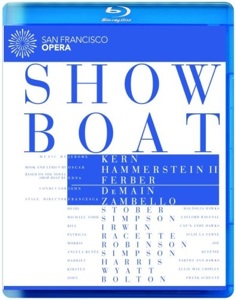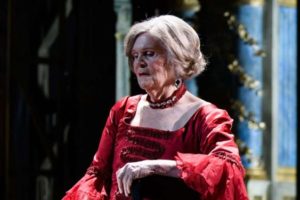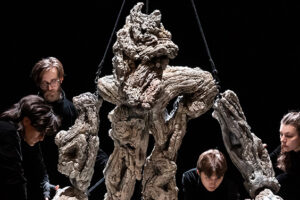
When the Houston Grand Opera, Washington National Opera, Lyric Opera of Chicago and San Francisco Opera announce they’re going to grubstake a production, you wouldn’t be at all surprised that they have chosen a classic American work. You might be surprised, though, when that title turns out to be Show Boat.
Although HGO does have a history with a touring production back in the 80’s, the other companies involved had only dipped that particular toe in the water up to Porgy and Bess. But Show Boat, while not an opera by any means, could definitely qualify as an operetta based on the quality of its music and the size of the forces it requires to do it justice. This new release from Euroarts is the whistle stop of the show boat Cotton Blossom at the San Francisco Opera filmed in June of last year. The production is directed by Francesca Zambello and conducted by John DeMain and is available on both on DVD and Blu-ray disc.
The narrative that surrounds the adaptation of Edna Ferber’s popular novel by Jerome Kern and Oscar Hammerstein II has been recounted in many fine books. It received a seminal recording in 1988 by John McGlinn with the London Sinfonietta on EMI that included virtually everything that had been written for the show including numbers cut in tryouts, new inserts into the first London production, and a few songs added to the 1936 Universal film
. I have nothing but side eye for the 1951 MGM spectacle
which is, sadly, how most people know this great piece of Americana.
Show Boat’s integration of character, music, and plot, unique for its time, can be said to mark the birth of the modern American musical. The story follows the cast and crew of the show boat Cotton Blossom on the Mississippi from 1887 to 1927, seen mostly through the eyes of Magnolia Hawkes who is the daughter of the Captain, pardon me, Cap’n. The characters’ lives are fraught with so much misfortune and adversity that at times it plays out like a gardenia- scented hybrid of Gone with the Wind and Voyage of the Damned. Spread out over 19 scenes and two acts, the original production ran four and a half hours out of town but was finally paired down to three hours by its Broadway opening. In whatever version, it makes La forza del destino seem downright succinct.
There have been a string of cast albums starting with the 1928 London premiere, but one of the reasons McGlinn’s was the game-changer was because it reinstated “Mis’ry’s Comin’ Round” in Act I which sets up and underscores the famous “miscegenation” scene. It’s a powerful number when performed in context and one which, although was cut in previews, Kern used liberally in the overture and underscoring.
One of the primary problems with Show Boat is its depiction of race. This was the first musical to speak out on interracial marriage. Ferber, Kern, and Hammerstein, all liberals of Jewish heritage, in recent years they have come under fire for a perceived one-dimensionality of the African-American characters in the story.
The most accursed racial epithet in our society is actually the very first word of Hammerstein’s libretto. Regardless of its intended effect and shock value on a complacent, bourgeois audience, that word has generally been changed in revivals of the show. (McGlinn’s recording controversially stuck to that original opening.)
Further complications arise when you learn that the actress who played Queenie, the Cotton Blossom’s African-American cook, in the first production was the Italian-American actress Tess Gardella, who was famous for playing the stereotypical “mammy” character “Aunt Jemima” in vaudeville. She was the only member of the cast in black face. Fortunately, that “tradition” didn’t stick, as the first Queenie in the London production the following year was Alberta Hunter.
Nonetheless Show Boat is deserving of serious mountings and since Broadway simply can’t currently afford to produce a show on this scale, we should be grateful for opera companies willing to take up the slack. And yet, an opera house Is not the ideal home for this piece. The War Memorial Opera House seats just over 3,100, far too large for a dialogue-heavy work. On this video, the play their parts so they register to the back of the theatre. Seen in closeup, everyone seems to be shouting the whole time. However, an extraordinarily accomplished cast has been assembled, many of whom manage to bridge that great divide from stage to home theater.
The owners of the Cotton Blossom are played by the estimable duo of Bill Irwin and Harriet Harris. Mr. Irwin, supremely gifted clown he may be, has never been an adherent to the theatrical philosophy of “less is more.” Here he looks like a high voltage electrical current is being run through his body at all times and not always for good reason. In a part that requires not a little pathos his shenanigans subvert the humanity of his character.
I worship at the shrine of Ms. Harris, the most gifted character actress I have ever seen on stage or screen but she’s at sea as the shrewish Parthy. True, she lands every gag, but only by growling like a prison warden during a laundry strike.
Then there are the supporting players of the Cotton Blossom, Ellie Mae Chipley and Frank Schultz, played by Kristen Wyatt and John Bolton. I have to hand it to both of them because you’d think performers like this didn’t even exist any longer. They’re both so steeped in vaudeville schtick, it’s like there’s been a tear in the theatrical time/space continuum. Mr. Bolton, by far the more understated of the two, has a lovely voice, is light on his feet, and displays a courtly demeanor. Ms. Wyatt, on the other hand, seems determined not to let a moment go by without her wringing it dry of its every theatrical opportunity. She dances and sings at an energy level so high she makes Shirley Temple appear funereal by comparison. One can only pray she doesn’t go into politics.
The workers on board are Joe, the stevedore, and his wife Queenie, the ship’s cook, played by Morris Robinson and Angela Renée Simpson. Mr. Robinson has a voice and then some. He blows a hole straight through “Ol’ Man River” and when the second verse started with the chorus backing him up, my tears began to flow. Ms. Simpson does her best with her down-home dialogue and makes something special of the often cut 11’o’clock number “Hey Fella!’ Both provide worthy anchors for the story.
Gaylord Ravenal is played by Michael Todd Simpson and he is leading man tall with a well supported and attractive middle-weight Baritenor. He sings very beautifully in spots and has breath to spare which is a plus. He just seems to lack that one extra helping of good-looking bastard that would make his characterization riveting rather than perfectly adequate.
Heidi Stober is so completely at home in this genre I was surprised to see a very accomplished list of operatic credits in her bio online. She gives a wholly winning performance as Magnolia Hawkes, if a little more believable when she’s playing younger than her years than
later when she’s playing older than she really is. She ratchets up the melodrama in her letter scene in Chicago when she discovers Ravenal has abandoned her for good, but, after all, she’s got a big space to fill. She also gives a stunning pianissimo reprise in the duet “You are love”
The last couple onboard are the leading lady Julie LaVerne and her husband Steve Baker. Patrick Cummings plays Steve in a strong, forthright fashion but it’s a cameo role and he’s long gone by the second act. I was a little dismayed when I saw that Julie was being played by Patricia Racette, but had a massive change of heart once I saw her performance. She’s more than at home in the idiom and manages almost better than anyone in the cast to keep her performance toned and sized for the house and the home screen. She has an alluring southern accent and launches into the act one anthem”Can’t help lovin’ dat man” with easy confidence. Her reactions during the lead up to the famous miscegenation scene are well-timed and she’s a woman destroyed by its outcome.
Julie’s return in Act II of course leads to the other truly great song in this show,”Bill’ with music by Kern but lyrics credited to P.G. Wodehouse (though they were touched up by Hammerstein.) For those of us who enjoy watching our divas wallowing in remorse and self pity Ms. Racette serves it up it in such heaping spoonfuls she’s like a cross between Aprile Millo and the wreck of the Hesperus. I have no higher praise.
Director Francesca Zambello had previously staged Show Boat as a spectacular at the Royal Albert Hall in 2006. One would have hoped that experience would lead to some insights in how to present this work for a modern audience. But she brings little more than the inventiveness of a traffic cop to this staging. She does manage to adroitly integrate the lively work of choreographer Michele Lynch into the proceedings. Luckily all the leads are more than game to participate in the various cakewalks, shuffles, and Charlestons. The large scale musical numbers are the highlights of the performance and show off the accomplishment of the chorus and ballet of the San Francisco Opera.
The costumes of Paul Tazewell are especially sharp and bright and their detail and meticulous construction hold up well on the home screen. They capture period and place far better than the bare bones sets of Peter J. Davison which really seem designed solely to be shifted quickly and travel easily. Outside of the skeleton of the Cotton Blossom, most everything is represented by flat backdrops, with varying degrees of success. The drop representing the Palmer House in Chicago is especially bizarre looking, something left over from a Luca Ronconi production at La Scala. Lighting design by Mark McCullough is fine throughout and he does well with the many transitions of locale.
The San Francisco Opera Orchestra is conducted by John DeMain, who led that Houston touring production way back when. He obviously relishes the change to work with a fuller version of the score than before and it’s an embarrassment of riches to hear a group this size playing this music with such verve and artistry. When was the last time you heard a string section that included a banjo?
My biggest problem comes with the television director Frank Zamacona. His cameras just seem to never be in the right spot at the right time. He always seems to be catching up to the focal point or concentrating on a reaction rather than the action. The sentimental coda of this piece with the old lady on the levee is a moment of frustration as the camera bounces back and forth for reaction shots, with the actors who are speaking lines mostly out of frame. It’s a fail.
Picture and sound are excellent and the DVD comes with two discs. The second of which is solely dedicated to some brief interviews with the cast members, conductor, and director. I will say absolutely beautiful cardboard packaging with lavish color photos and a full color program booklet with essays by DeMain and Zambello.
In spite of a meager physical production and perhaps some too-lively performances this video is infinitely preferable to the MGM bastardization since it’s as note-complete musically as we’ll probably ever get.

























Comments